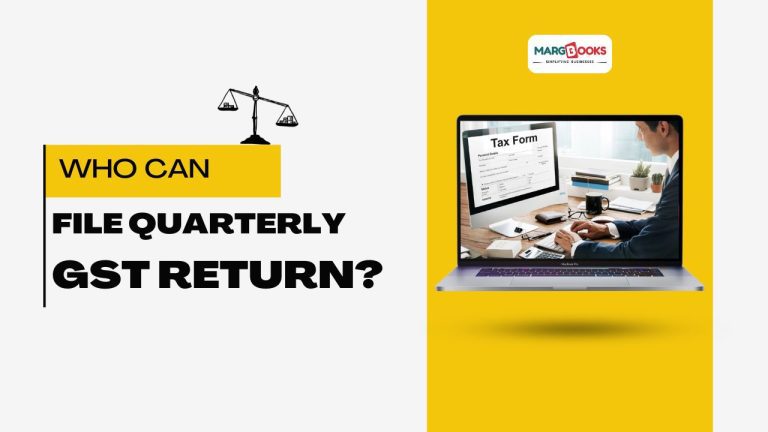In India, the Goods and Services Tax (GST) is one of the most significant tax reforms aimed at simplifying the indirect tax structure. One of the compliance measures under GST is the filing of returns, which needs to be done periodically. For most taxpayers, filing returns is a monthly task. However, under certain conditions, a taxpayer can opt for filing quarterly returns. This option is highly beneficial for small businesses as it reduces their compliance burden. In this blog, we will explore the concept of quarterly GST returns in detail, focusing on who can file quarterly GST returns, the eligibility criteria, and how this impacts businesses.
Understanding the GST Return Filing System
Before diving into who can file quarterly GST returns, it is essential to understand the basic structure of GST return filing. Every registered taxpayer under the GST regime is required to file returns to report sales, purchases, input tax credits, and tax liabilities. The filing frequency—monthly or quarterly—depends on the type of taxpayer and the aggregate turnover of their business.
The government offers quarterly return filing options under the QRMP Scheme (Quarterly Return Monthly Payment Scheme). This scheme is designed for small businesses to file their returns less frequently while ensuring that tax payments are made monthly.
What is a Quarterly GST Return?
A quarterly GST return allows eligible taxpayers to submit their GST returns once every three months instead of every month. This reduces the burden of frequent return filing for small and medium-sized businesses. However, it is important to note that while the returns are filed quarterly, the payment of taxes still has to be made on a monthly basis under the QRMP Scheme. This method ensures that the government receives tax payments regularly while providing some relief to businesses from the paperwork.
Who Can File Quarterly GST Return?
There are certain taxpayers that can opt for quarterly GST return filing, and these criteria are based mainly on the annual aggregate turnover of the business.
According to GST regulations, businesses with an aggregate turnover of up to ₹5 crores in the previous financial year can opt for the quarterly return filing. This turnover limit is calculated as the total value of all taxable supplies (excluding GST) made by a registered taxpayer.
If a taxpayer’s turnover exceeds ₹5 crores during the financial year, they will no longer be eligible for the quarterly return option. In such cases, they will be required to switch back to monthly return filing.
Eligibility for Quarterly GST Return: In Detail
- Turnover Limit: As mentioned, the taxpayer must have an aggregate turnover of up to ₹5 crores in the previous financial year. It is important to regularly check turnover figures, as exceeding this limit disqualifies the business from quarterly filing.
- Registration Status: Only registered taxpayers under the regular GST scheme (not composition taxpayers) can opt for quarterly filing under the QRMP scheme. Composition taxpayers, who already file returns on a quarterly basis under GSTR-4, are not eligible for this scheme.
- Return Filing Compliance: The taxpayer should be compliant with return filing in the previous periods. Non-compliance or delay in filing earlier GST returns may affect the eligibility to opt for quarterly returns.
- Option Selection: Taxpayers must select the quarterly return filing option online on the GST portal at the beginning of each quarter. This means businesses can decide whether to file quarterly or monthly based on their preferences, as long as they meet the eligibility criteria.
Benefits of Quarterly GST Return Filing
The option to file GST returns quarterly is beneficial for eligible taxpayers in several ways:
- Reduced Compliance Burden: Small businesses often find monthly return filing to be a burden as it involves substantial paperwork and documentation. Filing quarterly returns allows businesses to focus more on operations rather than compliance.
- Cost-Effective: Monthly filing of returns often requires businesses to hire accountants or tax professionals, leading to additional costs. With quarterly returns, these costs can be reduced as the frequency of return preparation decreases.
- Time-Saving: Small business owners who manage their own tax filings find that quarterly returns save significant time. The process of gathering information, reviewing, and filing returns every month is time-consuming. Filing only four returns per year reduces this workload considerably.
- Flexibility in Tax Payments: Although returns are filed quarterly, businesses still need to make tax payments monthly. The QRMP scheme provides flexibility in tax payment methods, allowing businesses to pay based on self-assessed liabilities or through the fixed sum method.
How to Opt for Quarterly GST Return Filing
Opting for quarterly GST returns is a straightforward process and can be done via the GST portal. Here’s how eligible taxpayers can choose to file their returns quarterly:
- Log in to the GST Portal: Taxpayers need to log in to the GST portal using their credentials.
- Select Quarterly Option: In the dashboard, there is an option to select the quarterly return filing frequency. Taxpayers can choose this option at the beginning of each quarter.
- Confirm the Selection: Once the quarterly filing option is selected, the system will ask for confirmation. After confirmation, the taxpayer will be able to file GSTR-1 and GSTR-3B on a quarterly basis.
Types of Returns Under Quarterly Filing
For taxpayers opting for quarterly return filing under the QRMP Scheme, the following returns are applicable:
- GSTR-1: This return contains details of outward supplies made during the quarter. Taxpayers are required to file GSTR-1 once every quarter to report their sales and issue invoices to customers.
- GSTR-3B: This is a simplified summary return that contains information about the taxpayer’s total sales, input tax credits, and tax liabilities. It needs to be filed quarterly under the QRMP scheme.
It’s important to note that while GSTR-3B is filed quarterly, businesses must still make tax payments every month based on their self-assessment or a fixed percentage of the previous month’s tax liability.
QRMP Scheme and Monthly Payments
Even though the returns are filed quarterly, businesses are required to make monthly tax payments under the QRMP scheme. There are two options for making these payments:
- Fixed Sum Method: Under this method, businesses can make tax payments based on a fixed percentage of the tax paid in the last quarter. This percentage is calculated by the GST system and is displayed in the taxpayer’s dashboard.
- Self-Assessment Method: Taxpayers who prefer more control over their tax payments can opt for the self-assessment method. Under this option, they calculate their tax liabilities based on the actual supplies made during the month and make payments accordingly.
Late Fees and Penalties
Taxpayers opting for quarterly returns need to be cautious about late fees and penalties. Failing to file quarterly returns on time can lead to hefty penalties. The GST law specifies that for every day a return is delayed, a late fee will be imposed. Additionally, taxpayers will also be liable to pay interest on the tax amount not paid by the due date.
It’s crucial for businesses to ensure timely filing of returns and payment of taxes to avoid such penalties. Despite the relaxation of filing frequency, compliance with deadlines remains essential.
Quarterly vs Monthly GST Return Filing
While quarterly return filing is an excellent option for small businesses, there are pros and cons to consider. Some businesses may prefer monthly filing if they regularly receive input tax credits and want to claim them without delay. On the other hand, businesses with fewer transactions may find quarterly filing more convenient.
Let’s compare the two options:
- Quarterly Filing:
- Fewer returns to file (only four per year).
- Suitable for businesses with less frequent transactions.
- Monthly tax payments still required.
- Monthly Filing:
- Suitable for larger businesses with frequent transactions.
- Allows for faster claim of input tax credits.
- More administrative work and higher compliance burden.
Impact of Quarterly GST Return Filing on Small Businesses
Quarterly GST return filing is a game-changer for small businesses in India. With reduced compliance and a focus on simplified tax management, small businesses can dedicate more time to growth and less time to administrative work. Additionally, the flexibility in choosing between quarterly and monthly filing allows businesses to opt for what suits their needs best.
Also Read
- How Secure is Your GST Data with Online GST Filing Software?The adoption of GST filing software has become a pivotal part of the business ecosystem in India. With the introduction of the Goods and Services Tax (GST), businesses have had to streamline their accounting practices and filing processes. However,… Read more: How Secure is Your GST Data with Online GST Filing Software?
- Why is GST Reconciliation Software a Game-Changer for Accountants and CAs?Managing finances and adhering to tax regulations can often become a daunting task, especially for accountants and Chartered Accountants (CAs) in India. One of the biggest challenges they face is ensuring proper GST (Goods and Services Tax) compliance. This… Read more: Why is GST Reconciliation Software a Game-Changer for Accountants and CAs?
- What Details Must be Included in a Sale Bill with GST?Getting your GST paperwork wrong feels like walking through a minefield, doesn’t it? One missing detail on your invoices, and suddenly you’re dealing with compliance headaches that could’ve been easily avoided. Creating a proper Sale Bill with GST isn’t… Read more: What Details Must be Included in a Sale Bill with GST?
- How Is a Purchase Bill with GST Different from a Sales Invoice?Running a business in today’s GST-enabled economy requires more than just selling and buying. It’s about being organised, compliant, and aware of what each document in your billing system stands for. One common confusion many businesses face is the… Read more: How Is a Purchase Bill with GST Different from a Sales Invoice?
- How Can You Generate a Mobile GST Bill in Seconds?Running a shop is hard enough. But when billing takes forever and GST compliance gets messy, things can slow down. That’s where a Mobile GST Bill comes to the rescue. Whether you run a busy garment store or a… Read more: How Can You Generate a Mobile GST Bill in Seconds?
Frequently Asked Question
Who is eligible to file quarterly GST returns?
Businesses with an annual turnover of up to ₹5 crores are eligible to file quarterly GST returns under the QRMP scheme. This option reduces the filing frequency from monthly to quarterly.
What is the QRMP scheme in GST?
The QRMP scheme stands for Quarterly Return Monthly Payment. It allows small businesses to file GST returns every quarter while paying their taxes monthly, easing the compliance process.
Can I switch from monthly to quarterly GST filing?
Yes, businesses can switch to quarterly filing if they meet the eligibility criteria of having an annual turnover of up to ₹5 crores. The switch can be done at the beginning of each quarter.
How often do I need to pay taxes under quarterly filing?
Although the returns are filed quarterly, businesses are still required to pay GST monthly under the QRMP scheme, using either the fixed sum or self-assessment method.
What forms are used for quarterly GST return filing?
Under the quarterly filing system, businesses need to file GSTR-1 (outward supplies) and GSTR-3B (summary return) once every quarter. Taxes, however, must be paid monthly.
Can I change my GST return filing option during the year?
Yes, you can change your filing option at the beginning of each quarter. You can choose to file monthly or quarterly depending on your eligibility and business needs.
What happens if I miss the quarterly GST filing deadline?
If you miss the deadline for filing quarterly GST returns, late fees and penalties will apply. You may also have to pay interest on any unpaid tax amounts.
Is quarterly GST return filing mandatory for all businesses?
No, quarterly filing is not mandatory for all businesses. It is an option available to businesses with an annual turnover of up to ₹5 crores. Larger businesses must file monthly returns.
How does the fixed sum payment method work in QRMP?
In the fixed sum method, the GST system calculates a fixed tax amount based on the previous quarter’s filings. You can pay this amount monthly if you choose this method.
What are the benefits of quarterly GST return filing?
Quarterly filing reduces the administrative burden for small businesses, saves time, and cuts down on the cost of compliance. It allows for less frequent paperwork and filing.






